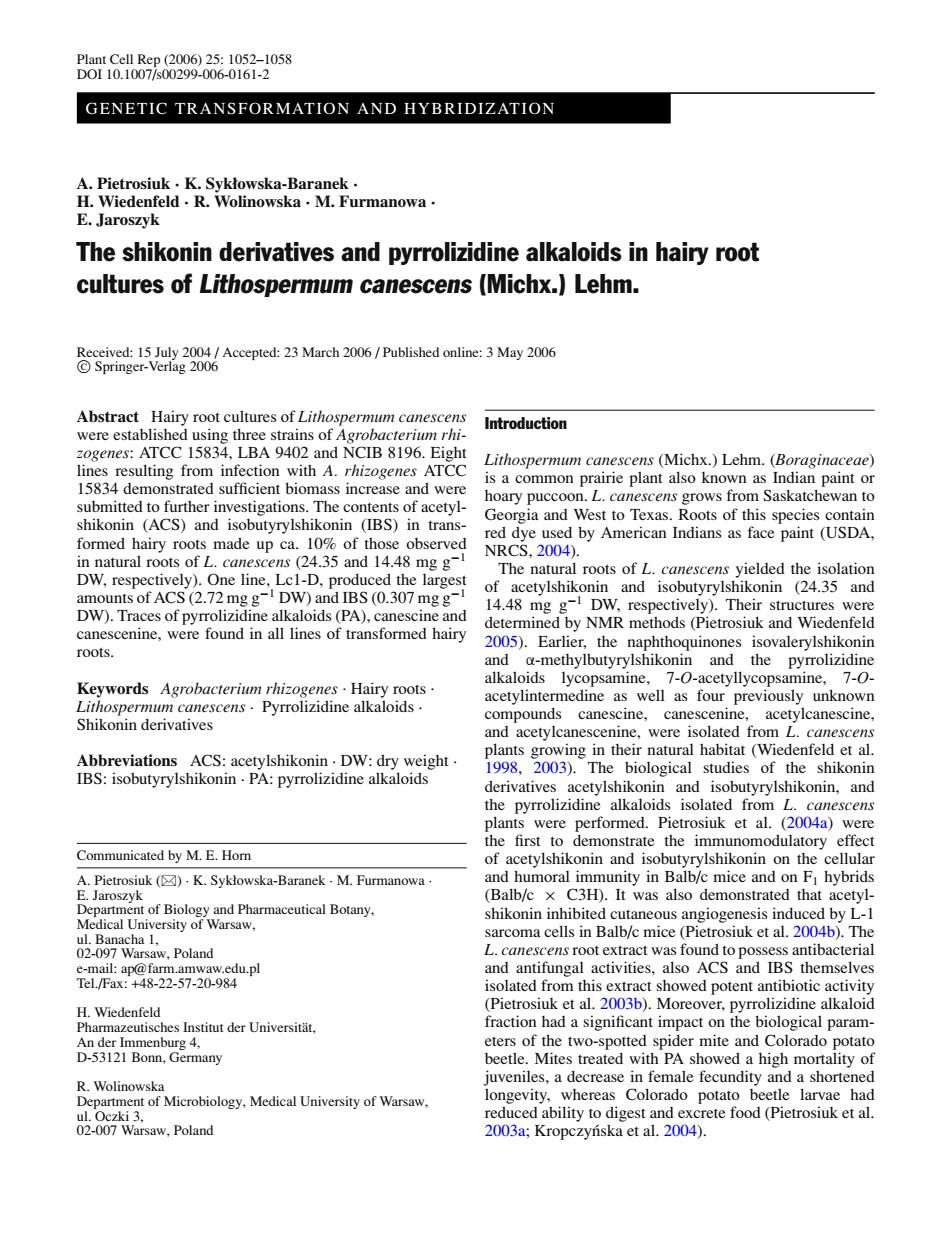正在加载图片...

P1 ant Cell Rep(2006)25:1052-1058 D0I10.1007/s00299-006-0161-2 GENETIC TRANSFORMATION AND HYBRIDIZATION A.Pietrosiuk·K.Syklowska-Baranek· H.Wiedenfeld.R.Wolinowska.M.Furmanowa. E.Jaroszyk The shikonin derivatives and pyrrolizidine alkaloids in hairy root cultures of Lithospermum canescens (Michx.)Lehm. Received:15 July 2004/Accepted:23 March 2006/Published online:3 May 2006 C Springer-Verlag 2006 Abstract Hairy root cultures of Lithospermum canescens Introduction were established using three strains of Agrobacterium rhi- zogenes:ATCC 15834,LBA 9402 and NCIB 8196.Eight lines resulting from infection with A.rhizogenes ATCC Lithospermum canescens (Michx.)Lehm.(Boraginaceae) is a common prairie plant also known as Indian paint or 15834 demonstrated sufficient biomass increase and were submitted to further investigations.The contents of acetyl- hoary puccoon.L.canescens grows from Saskatchewan to shikonin (ACS)and isobutyrylshikonin (IBS)in trans- Georgia and West to Texas.Roots of this species contain formed hairy roots made up ca.10%of those observed red dye used by American Indians as face paint(USDA, NRCS.2004). in natural roots of L.canescens (24.35 and 14.48 mg g- DW,respectively).One line,Lc1-D,produced the largest The natural roots of L.canescens yielded the isolation amounts of ACS(2.72 mg g-DW)and IBS(0.307 mg g- of acetylshikonin and isobutyrylshikonin (24.35 and DW).Traces of pyrrolizidine alkaloids(PA),canescine and 14.48 mg g-DW,respectively).Their structures were determined by NMR methods(Pietrosiuk and Wiedenfeld canescenine,were found in all lines of transformed hairy 2005).Earlier,the naphthoquinones isovalerylshikonin roots. and a-methylbutyrylshikonin and the pyrrolizidine alkaloids lycopsamine,7-0-acetyllycopsamine, 7-0- Keywords Agrobacterium rhizogenes.Hairy roots. acetylintermedine as well as four previously unknown Lithospermum canescens.Pyrrolizidine alkaloids. compounds canescine,canescenine,acetylcanescine, Shikonin derivatives and acetylcanescenine,were isolated from L.canescens Abbreviations ACS:acetylshikonin.DW:dry weight plants growing in their natural habitat (Wiedenfeld et al. IBS:isobutyrylshikonin.PA:pyrrolizidine alkaloids 1998,2003).The biological studies of the shikonin derivatives acetylshikonin and isobutyrylshikonin.and the pyrrolizidine alkaloids isolated from L.canescens plants were performed.Pietrosiuk et al.(2004a)were the first to demonstrate the immunomodulatory effect Communicated by M.E.Horn of acetylshikonin and isobutyrylshikonin on the cellular A.Pietrosiuk(☒),K.Syklowska-Baranek·M.Furmanowa and humoral immunity in Balb/c mice and on F hybrids E.Jaroszyk (Balb/c x C3H).It was also demonstrated that acetyl- Department of Biology and Pharmaceutical Botany, shikonin inhibited cutaneous angiogenesis induced by L-1 Medical University of Warsaw. ul.Banacha 1, sarcoma cells in Balb/c mice (Pietrosiuk et al.2004b).The 02-097 Warsaw,Poland L.canescens root extract was found to possess antibacterial e-mail:ap@farm.amwaw.edu.pl and antifungal activities,also ACS and IBS themselves Tel./Fax:+48-22-57-20-984 isolated from this extract showed potent antibiotic activity H.Wiedenfeld (Pietrosiuk et al.2003b).Moreover,pyrrolizidine alkaloid Pharmazeutisches Institut der Universitat. fraction had a significant impact on the biological param- An der Immenburg 4, eters of the two-spotted spider mite and Colorado potato D-53121 Bonn.Germany beetle.Mites treated with PA showed a high mortality of juveniles,a decrease in female fecundity and a shortened R.Wolinowska Department of Microbiology,Medical University of Warsaw, longevity,whereas Colorado potato beetle larvae had ul.Oczki 3. reduced ability to digest and excrete food (Pietrosiuk et al. 02-007 Warsaw.Poland 2003a;Kropczyniska et al.2004).Plant Cell Rep (2006) 25: 1052–1058 DOI 10.1007/s00299-006-0161-2 GENETIC TRANSFORMATION AND HYBRIDIZATION A. Pietrosiuk · K. Sykłowska-Baranek · H. Wiedenfeld · R. Wolinowska · M. Furmanowa · E. Jaroszyk The shikonin derivatives and pyrrolizidine alkaloids in hairy root cultures of Lithospermum canescens (Michx.) Lehm. Received: 15 July 2004 / Accepted: 23 March 2006 / Published online: 3 May 2006 C Springer-Verlag 2006 Abstract Hairy root cultures of Lithospermum canescens were established using three strains of Agrobacterium rhizogenes: ATCC 15834, LBA 9402 and NCIB 8196. Eight lines resulting from infection with A. rhizogenes ATCC 15834 demonstrated sufficient biomass increase and were submitted to further investigations. The contents of acetylshikonin (ACS) and isobutyrylshikonin (IBS) in transformed hairy roots made up ca. 10% of those observed in natural roots of L. canescens (24.35 and 14.48 mg g−1 DW, respectively). One line, Lc1-D, produced the largest amounts of ACS (2.72 mg g−1 DW) and IBS (0.307 mg g−1 DW). Traces of pyrrolizidine alkaloids (PA), canescine and canescenine, were found in all lines of transformed hairy roots. Keywords Agrobacterium rhizogenes . Hairy roots . Lithospermum canescens . Pyrrolizidine alkaloids . Shikonin derivatives Abbreviations ACS: acetylshikonin . DW: dry weight . IBS: isobutyrylshikonin . PA: pyrrolizidine alkaloids Communicated by M. E. Horn A. Pietrosiuk () · K. Sykłowska-Baranek · M. Furmanowa · E. Jaroszyk Department of Biology and Pharmaceutical Botany, Medical University of Warsaw, ul. Banacha 1, 02-097 Warsaw, Poland e-mail: ap@farm.amwaw.edu.pl Tel./Fax: +48-22-57-20-984 H. Wiedenfeld Pharmazeutisches Institut der Universitat, ¨ An der Immenburg 4, D-53121 Bonn, Germany R. Wolinowska Department of Microbiology, Medical University of Warsaw, ul. Oczki 3, 02-007 Warsaw, Poland Introduction Lithospermum canescens (Michx.) Lehm. (Boraginaceae) is a common prairie plant also known as Indian paint or hoary puccoon. L. canescens grows from Saskatchewan to Georgia and West to Texas. Roots of this species contain red dye used by American Indians as face paint (USDA, NRCS, 2004). The natural roots of L. canescens yielded the isolation of acetylshikonin and isobutyrylshikonin (24.35 and 14.48 mg g−1 DW, respectively). Their structures were determined by NMR methods (Pietrosiuk and Wiedenfeld 2005). Earlier, the naphthoquinones isovalerylshikonin and α-methylbutyrylshikonin and the pyrrolizidine alkaloids lycopsamine, 7-O-acetyllycopsamine, 7-Oacetylintermedine as well as four previously unknown compounds canescine, canescenine, acetylcanescine, and acetylcanescenine, were isolated from L. canescens plants growing in their natural habitat (Wiedenfeld et al. 1998, 2003). The biological studies of the shikonin derivatives acetylshikonin and isobutyrylshikonin, and the pyrrolizidine alkaloids isolated from L. canescens plants were performed. Pietrosiuk et al. (2004a) were the first to demonstrate the immunomodulatory effect of acetylshikonin and isobutyrylshikonin on the cellular and humoral immunity in Balb/c mice and on F1 hybrids (Balb/c × C3H). It was also demonstrated that acetylshikonin inhibited cutaneous angiogenesis induced by L-1 sarcoma cells in Balb/c mice (Pietrosiuk et al. 2004b). The L. canescensroot extract was found to possess antibacterial and antifungal activities, also ACS and IBS themselves isolated from this extract showed potent antibiotic activity (Pietrosiuk et al. 2003b). Moreover, pyrrolizidine alkaloid fraction had a significant impact on the biological parameters of the two-spotted spider mite and Colorado potato beetle. Mites treated with PA showed a high mortality of juveniles, a decrease in female fecundity and a shortened longevity, whereas Colorado potato beetle larvae had reduced ability to digest and excrete food (Pietrosiuk et al. 2003a; Kropczynska et al. ´ 2004)